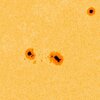SOLAR CYCLE 25 ACTIVITY REPORT OCTOBER 27
I think the most novel thing that has happened with the sun in the last few days is the the halloween pumpking-shaped coronal hole on the sun.

Everything remains at low levels, Only two B-class and two C-class flares. That was all. The largest event of the period was a C6.7 flare at 12:43 UTC from AR3133 (N25E58)
A couple of nice prominences on the Sun
Five active regions remain in the solar disk: AR3126, AR3130, AR3131, AR3132 and AR3133 All five have stable magnetic fields that post little threat for strong flares
The total number of sunspots has increased to 78 (28 of these are grouped into 5 active regions) NOAA forecast for the next 24h is 35% chance for C flares, 5% chance for M flares and 1% chance for X flares.
● Auroral Activity
The geomagnetic field has been at quiet levels for the past 24 hours. The solar wind speed record reached a peak of 386.1 km/sec at 03:38 UTC on October 27 The maximum planetary index Kp in the past 24h was Kp3
Aurora oval

● Current Conditions at 04:30 UTC on October 27
▪︎Geospace quiet
▪︎Geomagnetic conditions now Kp=1
▪︎Solar wind speed record: 377.5 km/sec
▪︎density: 12.84 protons/cm3
▪︎Neutron Counts today: +2.6% Elevated
▪︎X-ray Solar Flare: C2 at 01:26 UTC on Oct 27
▪︎Sunspot number: 78 (SN 72 Oct 26)
▪︎Solar wind flowing from the halloween pumpking-shaped coronal hole should reach Earth on Oct. 29-30
SpaceWeather.com
SpaceWeatherlive..com
I think the most novel thing that has happened with the sun in the last few days is the the halloween pumpking-shaped coronal hole on the sun.
THIS IS NO LAUGHING MATTER: There is a smiley face on the sun today. Take a look. Formed by holes in the sun's atmosphere, the cheerful mein is spewing a complex stream of solar wind toward Earth. First contact, with auroras, could occur on Oct. 28th or 29th. SpaceWeather.com
Everything remains at low levels, Only two B-class and two C-class flares. That was all. The largest event of the period was a C6.7 flare at 12:43 UTC from AR3133 (N25E58)
A couple of nice prominences on the Sun
Five active regions remain in the solar disk: AR3126, AR3130, AR3131, AR3132 and AR3133 All five have stable magnetic fields that post little threat for strong flares
The total number of sunspots has increased to 78 (28 of these are grouped into 5 active regions) NOAA forecast for the next 24h is 35% chance for C flares, 5% chance for M flares and 1% chance for X flares.
● Auroral Activity
The geomagnetic field has been at quiet levels for the past 24 hours. The solar wind speed record reached a peak of 386.1 km/sec at 03:38 UTC on October 27 The maximum planetary index Kp in the past 24h was Kp3
Aurora oval
● Current Conditions at 04:30 UTC on October 27
▪︎Geospace quiet
▪︎Geomagnetic conditions now Kp=1
▪︎Solar wind speed record: 377.5 km/sec
▪︎density: 12.84 protons/cm3
▪︎Neutron Counts today: +2.6% Elevated
▪︎X-ray Solar Flare: C2 at 01:26 UTC on Oct 27
▪︎Sunspot number: 78 (SN 72 Oct 26)
▪︎Solar wind flowing from the halloween pumpking-shaped coronal hole should reach Earth on Oct. 29-30
SpaceWeather.com
SpaceWeatherlive..com



